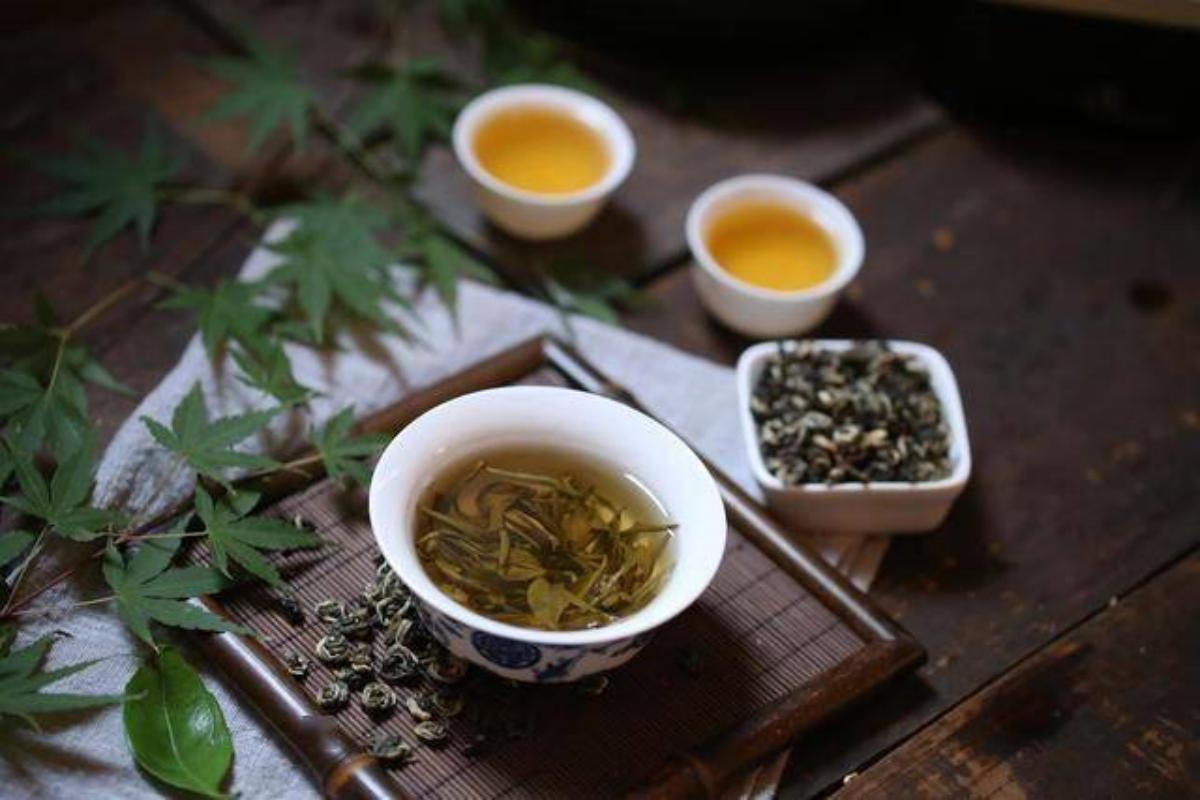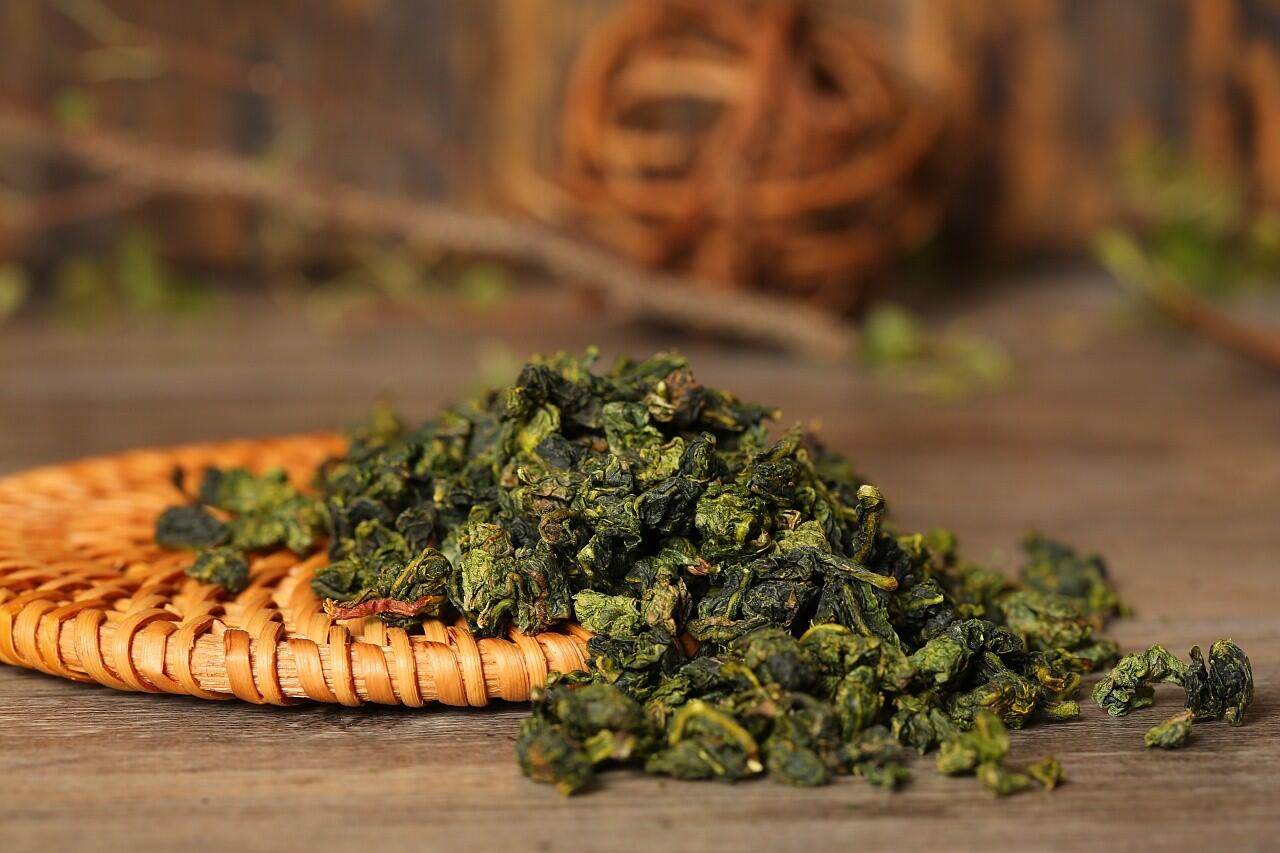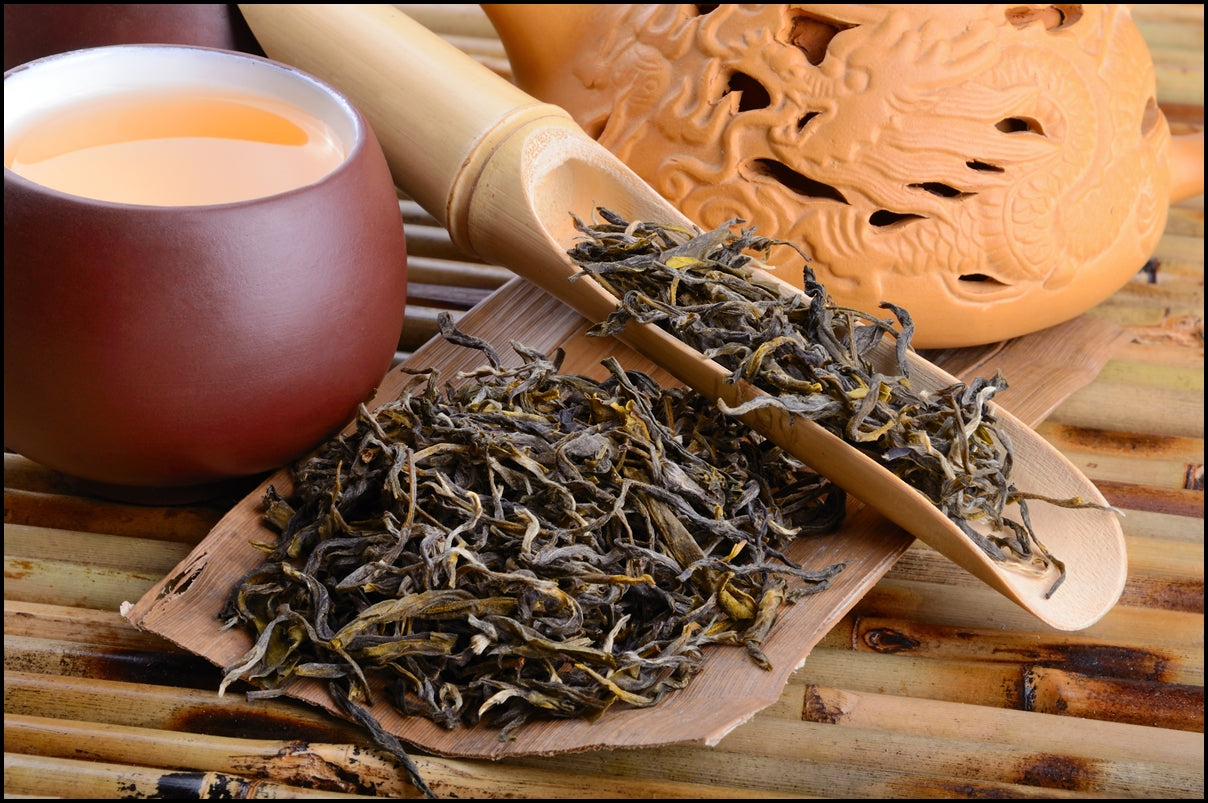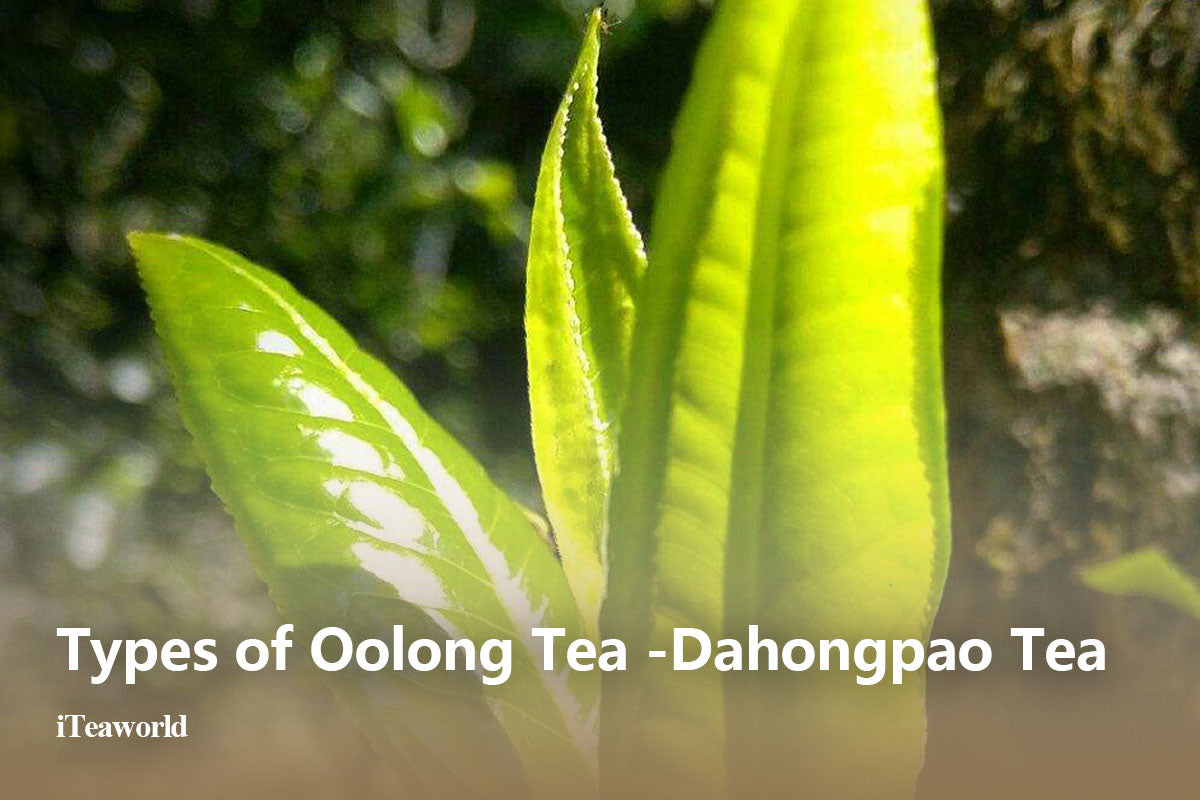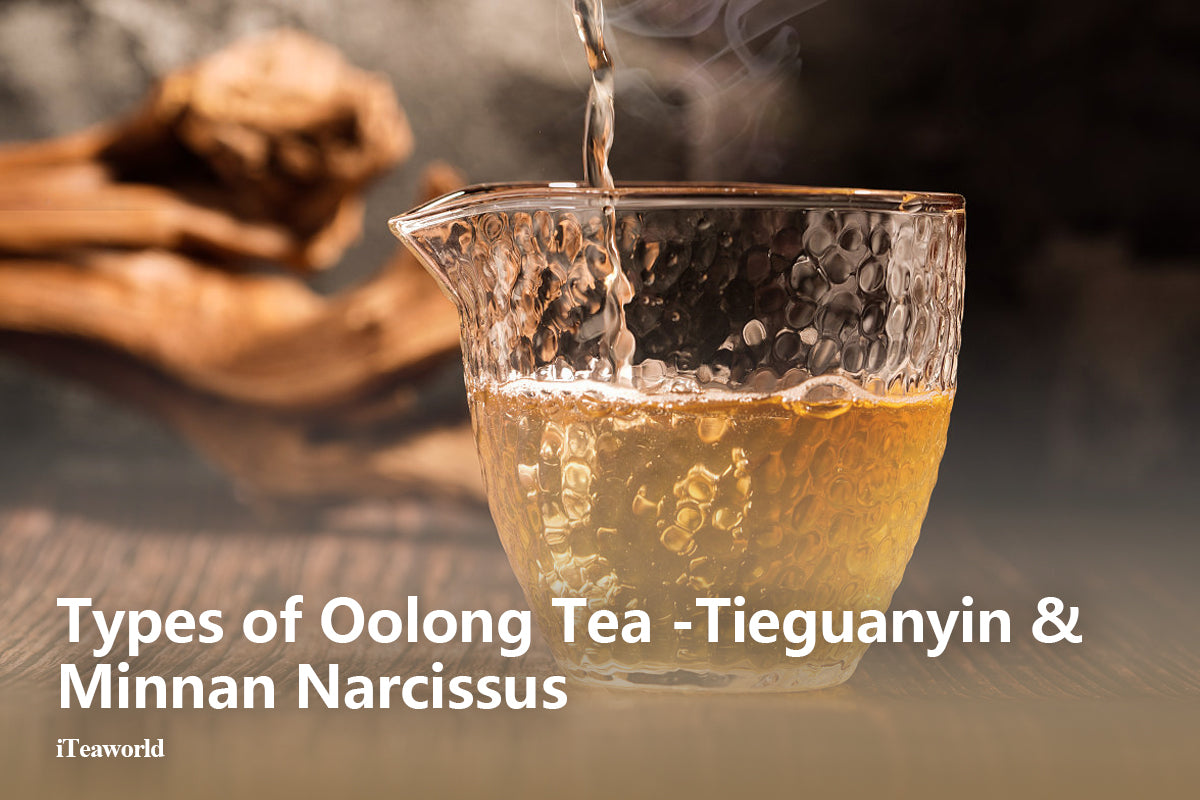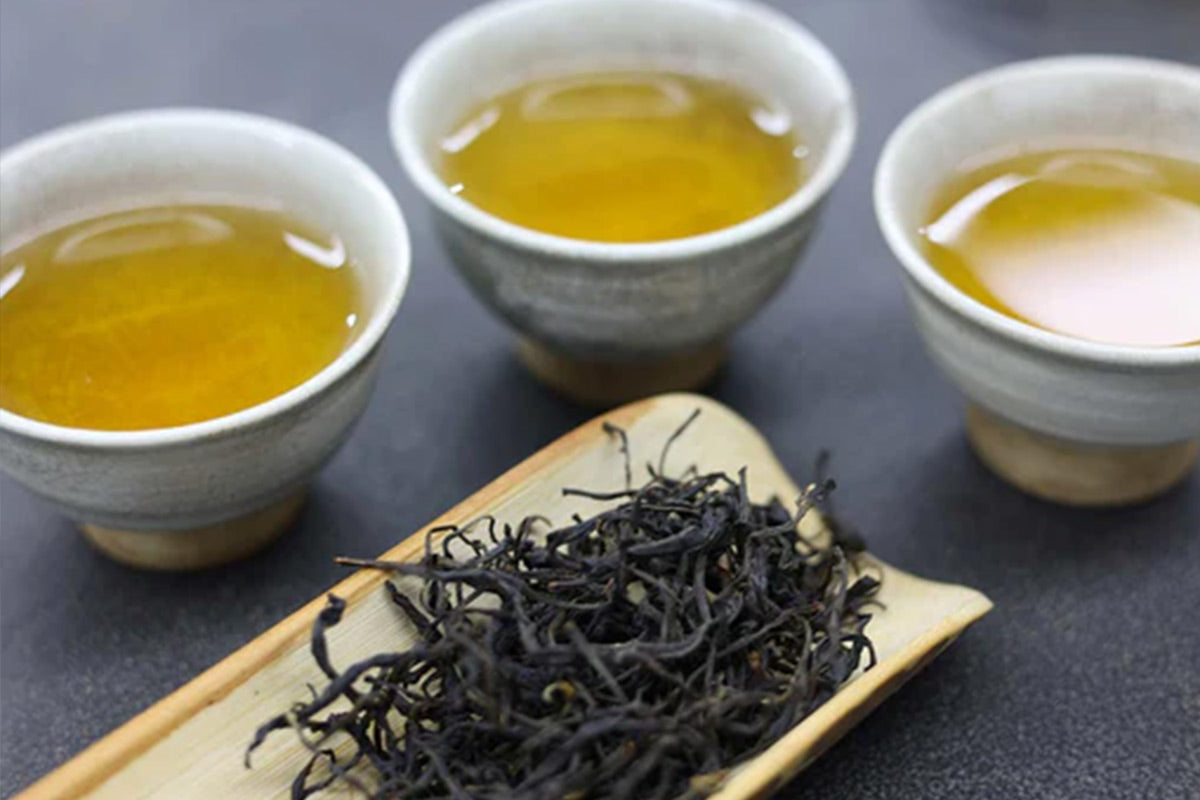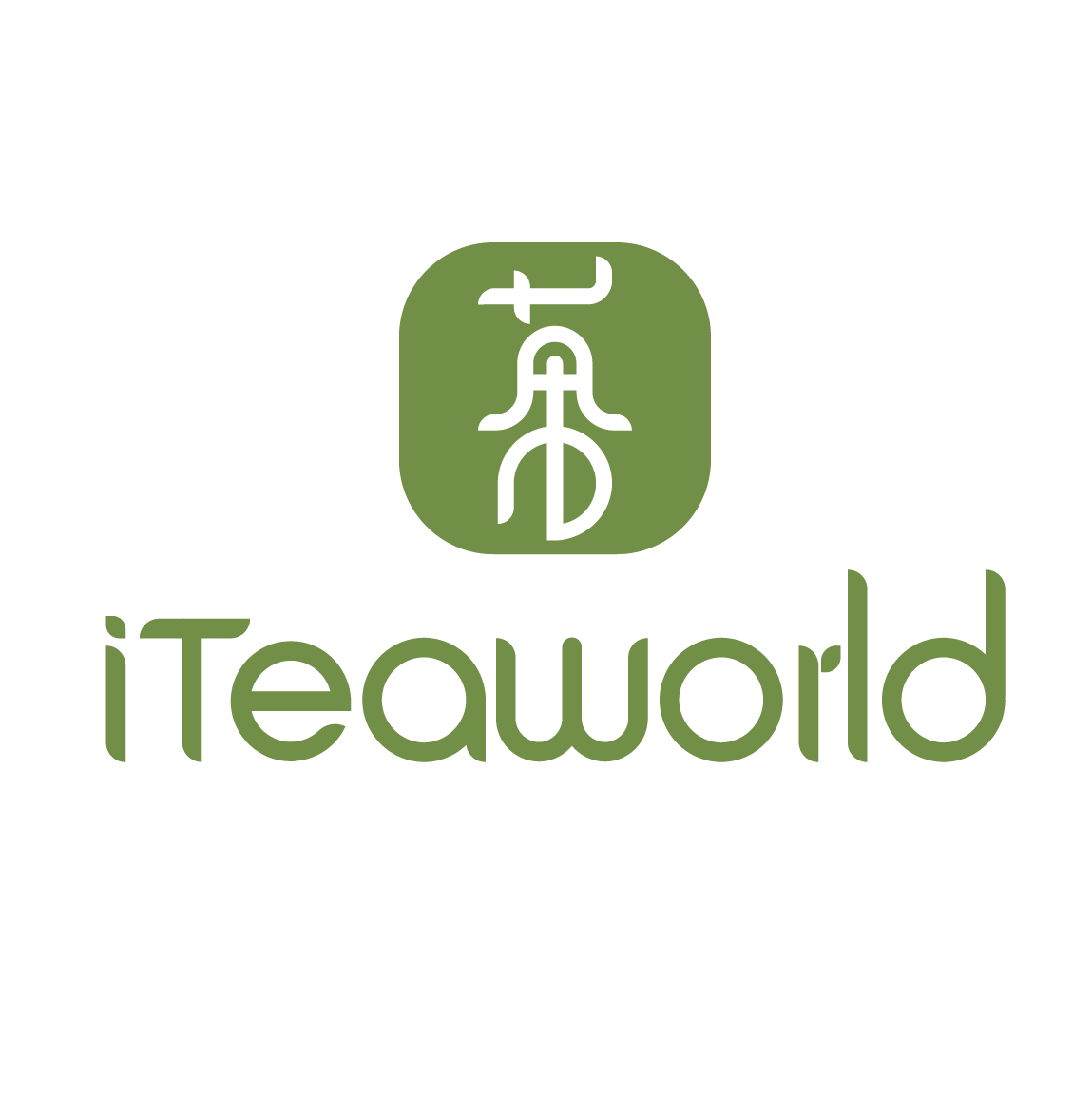Introduction
Tea, one of the oldest and most beloved beverages in the world, has a rich history steeped in tradition and cultural significance. From the mist-covered mountains of Anxi to the rocky cliffs of Wuyi Mountain and the picturesque landscapes of Guangdong and Fujian, tea-growing regions offer unique terroirs that impart distinct flavors and aromas to their teas. In this article, we invite you to embark on a journey of tea exploration as we delve into the enchanting world of four exceptional tea varieties: TieGuanyin Oolong Tea, Fenghuang Dancong Old Tree Oolong Tea (Mi Lan Xiang Honey Orchid), Dahongpao Oolong Tea (Big Red Robe), and Minnan Narcissus Oolong Tea.
Tea, with its myriad flavors and aromas, provides a sensory experience that captivates tea enthusiasts and novices alike. Each of these teas has its own unique character, influenced not only by the tea plant cultivar but also by the geographical location, climate, altitude, soil composition, and the expertise of tea artisans who carefully process the leaves. Understanding the nuances of these teas can enhance your appreciation for the artistry and craftsmanship behind each cup.
China is renowned for its rich tea culture, steeped in centuries of tradition and craftsmanship. Among the vast array of teas produced in this ancient land, several stand out as the epitome of excellence. From the perfumed elixir of Fenghuang Dancong Old Tree Oolong Tea to the legendary Dahongpao Oolong Tea of Wuyi Mountain, each variety offers a unique and captivating tea experience. In this article, we delve into the world of Chinese tea, focusing on the best loose leaf tea that showcase the artistry and flavors for which China is celebrated. Join us on this journey as we explore the finest teas that grace teacups worldwide.
1. TieGuanyin Oolong Tea: A Delicate Balance of Floral Aromas and Refreshing Taste
1.1. Origins and Significance
TieGuanyin Oolong Tea, also known as Iron Goddess of Mercy, traces its roots to the picturesque Anxi County in Fujian Province, China. This region is renowned for its favorable tea-growing conditions and the expertise of its tea artisans. TieGuanyin has a rich history dating back to the Qing Dynasty and holds a special place in Chinese tea culture.
1.2. Craftsmanship and Flavor Profile
The delicate balance of floral aromas and refreshing taste is a hallmark of TieGuanyin. Expertly plucked from selected cultivars of the Camellia sinensis plant, the tea leaves undergo a meticulous process of withering, oxidation, and roasting. This craftsmanship contributes to the tea's exquisite attributes.
1.3. Aromatic Sensory Experience
Brewing TieGuanyin offers a captivating sensory experience. The aroma unfolds with delightful notes of orchid, lilac, and osmanthus, creating an enchanting bouquet. As you take a sip, the taste reveals mild vegetal undertones, subtle sweetness, and a hint of mineral notes. The tea liquor boasts a beautiful apricot color, enhancing the visual appeal of each cup.
1.4. Versatility in Brewing
TieGuanyin is a versatile tea that can be enjoyed in various brewing styles, allowing for exploration of different flavors and aromas. For a lighter infusion, a shorter steeping time of around 30 seconds to 1 minute is recommended, resulting in a delicate brew. Conversely, a longer steeping time of 2-3 minutes will yield a bolder and more robust flavor.
1.5. Moderate Caffeine Content
With a moderate caffeine content, TieGuanyin is suitable for both morning and afternoon tea sessions. It provides a gentle pick-me-up without causing excessive stimulation. If you prefer to reduce your caffeine intake, a quick rinse of the tea leaves before brewing can help further decrease its caffeine content.
1.6. Choosing TieGuanyin Oolong Tea
When selecting TieGuanyin Oolong Tea, it is advisable to choose teas from reputable producers who adhere to traditional cultivation and processing methods. This ensures the preservation of the tea's authentic flavors and aromas. Exploring different grades of TieGuanyin, such as premium "Competition Grade" or more accessible "Commercial Grade," can offer a range of experiences to suit individual preferences and budgets.
1.7. Indulge in the Enchanting Flavors
Whether you are a seasoned tea connoisseur or a curious beginner, TieGuanyin Oolong Tea invites you to embark on a delightful journey into the world of oolong tea. Its delicate floral aromas, refreshing taste, and versatility in brewing options make it a beloved choice among tea enthusiasts worldwide. So sit back, relax, and savor the enchanting flavors of TieGuanyin Oolong Tea as it transports you to the misty tea gardens of Anxi.
1.8. The 300 Years Old Anxi Tie Guan Yin: A World Cultural Heritage
Amidst the rich tapestry of tea history, one particular variant stands out as a treasure of immense cultural significance—the 300 Years Old Anxi Tie Guan Yin. This extraordinary tea, hailing from the renowned tea-growing region of Anxi County in Fujian Province, China, has been designated as a World Cultural Heritage. Its age-old legacy and exceptional characteristics make it a true gem in the world of tea.
1.9. An Unparalleled Taste and Fragrance
The Anxi Tie Guan Yin captivates tea enthusiasts with its remarkable taste and fragrance. Renowned for its fresh and strong flavor, it delights the palate with a delicate balance of floral aromas and a refreshing aftertaste. The tea's fragrance, reminiscent of the captivating scent of orchids, adds a touch of elegance and sophistication to the overall experience.
1.10. A Feast for the Senses
When brewed, the Anxi Tie Guan Yin reveals its true splendor. Its tea soup color, reminiscent of the luscious hues of apricot, entices the eyes and enhances the visual appeal of each cup. As the aroma unfolds, the air fills with notes of orchid, lilac, and osmanthus, creating a sensory symphony that transports tea lovers to a world of enchantment.
1.11. Medium Caffeine Level for a Balanced Experience
For those seeking a harmonious tea experience, the Anxi Tie Guan Yin offers a moderate caffeine level, making it a perfect choice for both morning and afternoon tea sessions. It provides a gentle pick-me-up without overwhelming the senses, allowing tea enthusiasts to savor its flavors and aromas throughout the day. However, for those who prefer a lower caffeine intake, a quick rinse of the tea leaves prior to brewing can help further reduce its caffeine content.
1.12. Preserving Legacy and Authenticity
To fully appreciate the magnificence of the Anxi Tie Guan Yin, it is essential to choose teas from producers who adhere to traditional cultivation and processing methods. This ensures the preservation of its authentic flavors and aromatic profile, allowing tea enthusiasts to embark on an authentic journey through time.
1.13. A Tea for Every Palate and Budget
The Anxi Tie Guan Yin offers a wide range of options to suit different preferences and budgets. For those seeking the pinnacle of tea excellence, the premium "Competition Grade" teas present a truly exceptional choice. On the other hand, the more accessible "Commercial Grade" teas provide an opportunity for tea lovers to explore the world of Anxi Tie Guan Yin without compromising on quality.
1.14. Embrace the Heritage, Savor the Experience
As you delve into the world of tea, let the Anxi Tie Guan Yin be your guide. With its 300 years of history and the honor of being a World Cultural Heritage, it invites you to indulge in its enchanting flavors and embark on a delightful journey. Whether you are a seasoned tea connoisseur or a curious beginner, this extraordinary tea promises to transport you to the misty tea gardens of Anxi, where time stands still and the essence of tea comes alive. So sit back, relax, and immerse yourself in the timeless allure of the 300 Years Old Anxi Tie Guan Yin, a true testament to the artistry and legacy of tea.
2. Fenghuang Dancong Old Tree Oolong Tea: A Perfumed Elixir
2.1. Origins and Rarity
Fenghuang Dancong Old Tree Oolong Tea, also known as Phoenix Dancong, hails from the Fenghuang Mountain in the Guangdong Province of China. This unique tea variety is produced from ancient tea trees, some of which are several hundred years old. The combination of the specific cultivar and the age of the trees contributes to the tea's exceptional flavor and rarity.
Renowned for its captivating aromas, Fenghuang Dancong exhibits an incredible aromatic complexity. The tea leaves are meticulously hand-picked and processed to preserve their natural fragrance. Each Dancong variety showcases a distinct floral or fruity aroma, reminiscent of orchids, honey, gardenia, osmanthus, or almond blossoms. These fragrances have become the namesakes of the various teas, illustrating the diversity within the Fenghuang Dancong family.
2.2. Aromatic Complexity
One of the most captivating features of Fenghuang Dancong is its incredible aromatic complexity. The tea leaves are carefully hand-picked and processed with great precision to preserve the natural fragrance. Each Dancong variety exhibits a distinct floral or fruity aroma, often resembling the scent of orchids, honey, gardenia, osmanthus, or almond blossoms. The teas are named after these fragrances, showcasing the diversity of aromas within the Fenghuang Dancong family.
Brewing Fenghuang Dancong Old Tree Oolong Tea reveals a multi-layered flavor experience. The tea liquor boasts a smooth texture, balanced astringency, and a lingering sweetness. Its taste is often described as elegant and sophisticated, with notes that range from floral and fruity to honeyed and nutty. The combination of its unique fragrance and nuanced flavors creates a truly indulgent and memorable drinking experience.
2.3. Flavor Experience
Brewing Fenghuang Dancong Old Tree Oolong Tea unveils a multi-layered flavor experience. The tea liquor is known for its smooth texture, balanced astringency, and lingering sweetness. The taste is often described as elegant and sophisticated, with notes that range from floral and fruity to honeyed and nutty. The combination of the unique fragrance and nuanced flavors creates a truly indulgent and memorable drinking experience.
Traditionally, Fenghuang Dancong is enjoyed through the art of Gongfu Cha, a precise Chinese tea ceremony. This method involves multiple short infusions in small teapots or gaiwans, allowing the drinker to fully appreciate the tea's evolving flavors and aromas. Gongfu Cha enhances the complexity of Fenghuang Dancong, making it an ideal way to savor this remarkable tea.
Due to the rarity of ancient tea trees and the meticulous production process, Fenghuang Dancong Old Tree Oolong Tea is produced in limited quantities. It is essential to seek authenticity from reputable tea vendors who can trace the tea's origin and provide information about the specific cultivar and production methods. This ensures a genuine and high-quality tea experience, as counterfeit or lower-quality versions can be found in the market.
Within the family of Fenghuang Dancong, there are numerous distinct varieties, each offering its own unique aroma and flavor profile. Mi Lan Xiang (Honey Orchid Fragrance), Huang Zhi Xiang (Yellow Sprig Fragrance), and Xing Ren Xiang (Almond Fragrance) are among the popular ones. Exploring these different varieties allows tea enthusiasts to discover their personal favorites and appreciate the breadth of aromas and flavors offered by Fenghuang Dancong.
2.4. Art of Gongfu Cha
Fenghuang Dancong is often enjoyed using the traditional Chinese tea ceremony known as Gongfu Cha. This elaborate and precise method of brewing tea involves multiple short infusions in small teapots or gaiwans. Gongfu Cha allows the tea drinker to fully appreciate the tea's evolving flavors and aromas, making it an ideal way to experience the complexity of Fenghuang Dancong.
2.5. Limited Production and Authenticity
Due to the rarity of ancient tea trees and the meticulous production process, Fenghuang Dancong Old Tree Oolong Tea is produced in limited quantities. Authenticity is crucial when seeking this tea, as counterfeit or lower-quality versions can be found in the market. It is advisable to source Fenghuang Dancong from reputable tea vendors who can trace the tea's origin and provide information about the specific cultivar and production methods.
2.6. Exploring Dancong Varieties
Within the family of Fenghuang Dancong, there are numerous distinct varieties, each with its own unique aroma and flavor profile. Some popular ones include Mi Lan Xiang (Honey Orchid Fragrance), Huang Zhi Xiang (Yellow Sprig Fragrance), and Xing Ren Xiang (Almond Fragrance). Exploring these different varieties allows tea enthusiasts to discover their personal favorites and appreciate the breadth of aromas and flavors offered by Fenghuang Dancong.
2.7. An Exquisite Tea Experience
Fenghuang Dancong Old Tree Oolong Tea stands as a testament to the artistry and craftsmanship of Chinese tea production. Its rare and fragrant qualities, combined with the depth and complexity of its flavors, make it a truly exquisite tea experience. Whether savored during a meditative moment or shared with fellow tea lovers, Fenghuang Dancong offers an aromatic elixir that transports the senses and celebrates the rich tea heritage of Guangdong Province.
Fenghuang Dancong Old Tree Oolong Tea stands as a testament to the artistry and craftsmanship of Chinese tea production. Its rare and fragrant qualities, combined with the depth and complexity of its flavors, make it a truly exquisite tea experience. Whether enjoyed during a moment of meditation or shared with fellow tea lovers, Fenghuang Dancong offers an aromatic elixir that transports the senses and celebrates the rich tea heritage of Guangdong Province.
3. Dahongpao Oolong Tea: A Legend of Wuyi Mountain
3.1. Historical Significance and Legendary Origins
Dahongpao Oolong Tea, also known as "Big Red Robe," is a highly regarded oolong tea that originates from the Wuyi Mountain in Fujian Province, China. It holds deep historical and cultural significance and is considered one of the most famous and prestigious teas in China. According to legend, the tea gained its name when it was used to cure an emperor's illness, and the red robe was draped over the tea bushes as a sign of honor.
Thriving in the unique terroir of the Wuyi Mountain, Dahongpao tea bushes encounter challenging conditions that contribute to the tea's complexity. The rocky cliffs, mineral-rich soil, and misty microclimate of the region infuse this tea with a distinct flavor and aroma. It is from this core producing area that Dahongpao tea takes on its most authentic form.
3.2. Unique Terroir of Wuyi Mountain
Dahongpao thrives in the unique terroir of the Wuyi Mountain, which is characterized by its rocky cliffs, mineral-rich soil, and misty microclimate. These natural elements contribute to the distinctive flavor and aroma of the tea. The tea bushes grow in the rocky crevices of the mountainside, encountering challenging conditions that further enhance the tea's complexity.
Dahongpao is renowned for its complex and layered flavor profile. Each brew unveils a symphony of flavors that can include roasted chestnuts, honey, dried fruit, caramel, and a subtle mineral undertone. The tea strikes a perfect balance between sweetness and a slight toastiness, leaving a harmonious and lingering taste that evolves with each infusion.
3.3. Complex Flavor Profile
Dahongpao is renowned for its complex and layered flavor profile. When brewed, it offers a symphony of flavors that can include roasted chestnuts, honey, dried fruit, caramel, and a subtle mineral undertone. The tea strikes a perfect balance between sweetness and a slight toastiness, creating a harmonious and lingering taste that evolves with each infusion.
The unique flavor profile of Dahongpao is achieved through traditional roasting techniques. After careful harvesting, the tea leaves are skillfully roasted under gentle heat, often over charcoal or wood fires. This meticulous process imparts a sweet aroma with a light smoky scent, adding depth and richness to the tea while preserving its flavors and extending its shelf life.
3.4. Traditional Roasting Techniques
The unique flavor profile of Dahongpao is achieved through traditional roasting techniques. After being carefully harvested, the tea leaves are skillfully roasted over charcoal or wood fires. This roasting process imparts a distinct smokiness and depth to the tea, while also helping to preserve its flavors and extend its shelf life.
True Dahongpao is produced in limited quantities due to the scarcity of the original ancient tea bushes. As a result, this prestigious tea is highly sought after and often comes with a higher price tag. Its authenticity and exceptional quality make it a prized possession recognized by tea connoisseurs.
3.5. Limited Production and Prestige
True Dahongpao is produced in very limited quantities, as the original ancient tea bushes from which it is harvested are scarce. The demand for this prestigious tea greatly outweighs the supply, making it highly sought after and often quite expensive. Genuine Dahongpao is recognized by tea connoisseurs for its authenticity and exceptional quality.
Dahongpao holds a special place in Chinese tea culture, often being associated with traditional tea ceremonies and gifting rituals. It symbolizes prestige, elegance, and the appreciation of fine teas. Its long-standing reputation and cultural significance have elevated it to a symbol of Chinese tea heritage.
3.6. Cultural Significance and Tea Heritage
Dahongpao holds a special place in Chinese tea culture and is often associated with traditional tea ceremonies and gifting rituals. It symbolizes prestige, elegance, and the appreciation of fine teas. The tea's long-standing reputation and cultural significance have elevated it to a symbol of Chinese tea heritage.
While the original Dahongpao tea bushes are reserved for special occasions and limited releases, cultivated varieties of Dahongpao are also available. These teas replicate the unique flavor characteristics of the original ancient tea trees through clonal propagation techniques. Exploring these different varieties allows tea enthusiasts to experience the essence of Wuyi Mountain and appreciate the intricate nuances within this legendary tea category.
3.7. Exploring Dahongpao Varieties
While the original Dahongpao tea bushes are reserved for special occasions and limited releases, there are also cultivated varieties of Dahongpao available. These teas are produced using clonal propagation techniques to replicate the unique flavor characteristics of the original ancient tea trees. Exploring different varieties of Dahongpao allows tea enthusiasts to experience the essence of Wuyi Mountain and appreciate the intricate nuances within this legendary tea category.
3.8. A Tea Journey to Remember
Dahongpao Oolong Tea offers tea lovers a memorable journey into the world of Wuyi Mountain and the rich traditions of Chinese tea. Its legendary origins, complex flavor profile, and limited production make it a prized possession among connoisseurs. Savoring a cup of Dahongpao is not only a sensory delight but also a way to connect with centuries of tea heritage and immerse oneself in the legends and stories that surround this esteemed tea.
Embarking on a tea journey with Dahongpao Oolong Tea offers a memorable experience that delves into the world of Wuyi Mountain and the rich traditions of Chinese tea. Its legendary origins, complex flavor profile, and limited production make it a prized possession among connoisseurs. Savoring a cup of Dahongpao is not only a sensory delight but also a way to connect with centuries of tea heritage and immerse oneself in the legends and stories that surround this esteemed tea.
4. Minnan Narcissus Oolong Tea: The Sweet Indulgence of Fujian Province
4.1. Origins and Cultural Significance
Minnan Narcissus Oolong Tea, also known as "Shuixian" or "Water Sprite," originates from the Fujian Province in China. It is particularly celebrated in the Minnan region, which encompasses cities such as Xiamen and Quanzhou. With a history dating back several centuries, Minnan Narcissus Oolong Tea holds a special place in the tea culture of Fujian and is revered for its delightful flavors and aromas.
The latest addition to the Minnan Narcissus Oolong Tea family is a unique variety that has passed Japanese organic food safety tests. This exceptional tea is sourced from tea trees that have been growing for an impressive 60 years. Known for its highly resteepable nature and high sweetness, this tea offers an unparalleled tea-drinking experience.
4.2. Fragrant Floral Aromas
One of the defining characteristics of Minnan Narcissus Oolong Tea is its captivating floral aromas. The tea leaves are carefully processed to preserve the natural fragrance, resulting in a bouquet that evokes the scent of blooming flowers. Notes of gardenia, orchid, and narcissus intertwine to create an intoxicating olfactory experience that enhances the enjoyment of every sip.
With its captivating floral aromas and smooth, velvety texture, Minnan Narcissus Oolong Tea already holds a special place in the hearts of tea lovers. But the addition of this tea, cultivated from 60-year-old tea trees, takes its flavors and aromas to new heights. The tea leaves are carefully processed to preserve their natural fragrance, resulting in a bouquet that evokes the scent of blooming flowers, with notes of gardenia, orchid, and narcissus intertwining to create an intoxicating olfactory experience.
4.3. Sweet and Mellow Flavor Profile
Minnan Narcissus Oolong Tea offers a sweet and mellow taste that lingers on the palate. The tea liquor is known for its smooth and velvety texture, with flavors that range from honey and ripe fruit to hints of roasted nuts. The balanced and harmonious nature of the tea makes it a delightful indulgence for those seeking a gentle and satisfying tea experience.
The sweet and mellow flavor profile of Minnan Narcissus Oolong Tea is further enhanced by this unique variety. The tea liquor offers a delightful balance of honey, ripe fruit, and hints of roasted nuts, leaving a lingering, satisfying taste on the palate. Whether enjoyed through traditional Gongfu brewing or simpler Western-style preparations, this tea promises to deliver a gentle and indulgent tea experience.
4.4. Traditional Processing Techniques
The production of Minnan Narcissus Oolong Tea involves intricate and time-honored processing techniques. After the leaves are plucked, they undergo a meticulous process of withering, tossing, oxidation, and firing. This skilled craftsmanship is crucial in achieving the desired balance of flavors and aromas and contributes to the tea's exceptional quality.
Minnan Narcissus Oolong Tea is well-known for its rich heritage and traditional processing techniques, which contribute to its exceptional quality. The production of this tea involves meticulous steps, including withering, tossing, oxidation, and firing, all performed with skilled craftsmanship. These time-honored techniques ensure that the tea achieves the desired balance of flavors and aromas, allowing tea enthusiasts to savor the true essence of Fujian Province.
4.5. Versatility in Brewing Methods
Minnan Narcissus Oolong Tea is known for its versatility in brewing methods. It can be enjoyed in both traditional Gongfu style and simpler Western-style preparations. Gongfu Cha allows for multiple short infusions, gradually revealing the tea's evolving flavors. Alternatively, Western-style brewing involves longer steeping times, resulting in a more robust and full-bodied cup. Whichever method you choose, Minnan Narcissus Oolong Tea promises a delightful and satisfying tea experience.
In addition to its remarkable flavor and aroma, Minnan Narcissus Oolong Tea is also highly versatile in brewing methods. Whether you prefer the multi-infusion approach of Gongfu Cha or the robustness of Western-style brewing, this tea adapts to your preferences, revealing its evolving flavors with each sip. It's a tea that can be enjoyed in solitude or shared with friends and loved ones, creating memorable moments around a steaming cup.
4.6. Ideal for Dessert Pairings
The natural sweetness and mellow flavors of Minnan Narcissus Oolong Tea make it an excellent choice for pairing with desserts and sweets. The tea's floral undertones complement the richness of cakes, pastries, and even creamy desserts. Whether enjoyed alongside a delicate slice of sponge cake or a decadent chocolate treat, Minnan Narcissus Oolong Tea enriches the overall dessert experience.
Furthermore, the natural sweetness and mellow flavors of Minnan Narcissus Oolong Tea make it an ideal choice for dessert pairings. The floral undertones of the tea complement the richness of cakes, pastries, and creamy desserts, elevating the overall dessert experience. Whether you're enjoying a delicate slice of sponge cake or indulging in a decadent chocolate treat, this tea enriches the flavors and textures, creating a harmonious combination.
4.7. Embracing Fujian Tea Heritage
Minnan Narcissus Oolong Tea offers tea enthusiasts the opportunity to embrace the rich tea heritage of Fujian Province. Its fragrant floral aromas, sweet taste, and versatility in brewing methods make it a beloved choice among tea lovers. With every sip, you can immerse yourself in the cultural traditions and flavors of Minnan, savoring the sweet indulgence that this exquisite oolong tea provides.
Minnan Narcissus Oolong Tea invites tea enthusiasts to embrace the rich tea heritage of Fujian Province. Its fragrant floral aromas, sweet taste, and versatility in brewing methods have made it a beloved choice among tea lovers. And now, with the addition of this exceptional variety sourced from 60-year-old tea trees, the tea-drinking experience reaches new heights of delight and satisfaction.
4.8. Savor the Sweetness of Minnan Narcissus
Indulge in the sweet and fragrant experience of Minnan Narcissus Oolong Tea. Let the delicate floral aromas and mellow flavors transport you to the tea gardens of Fujian Province. Whether enjoyed during a peaceful moment of solitude or shared with friends and loved ones, Minnan Narcissus Oolong Tea offers a delightful and memorable tea drinking experience that embodies the essence of Fujian's tea culture.
Savor the sweetness of Minnan Narcissus Oolong Tea and let the delicate floral aromas and mellow flavors transport you to the tea gardens of Fujian Province. Immerse yourself in the cultural traditions and flavors of Minnan, and experience the sweet indulgence that this exquisite oolong tea provides. Whether enjoyed in moments of solitude or shared with loved ones, Minnan Narcissus Oolong Tea promises an unforgettable journey through the rich tea heritage of Fujian.
5. Comparing the Four Teas:Distinct Flavors and Aromas
While each of these teas offers a unique and captivating experience, let's compare them to help you choose the one that aligns with your preferences:
5.1. TieGuanyin Oolong Tea:
With its refreshing taste and delicate floral aroma, TieGuanyin is an excellent choice for those who enjoy a balanced and aromatic cup of tea. Its moderate caffeine content makes it suitable for both morning and afternoon consumption.
5.2. Fenghuang Dancong Old Tree Oolong Tea:
Known for its captivating perfume-like aroma, Fenghuang Dancong delights the senses with its fragrance. If you appreciate complex and aromatic teas that offer a sensory journey, this tea variety is for you.
5.3. Dahongpao Oolong Tea:
As a representative of Wuyi Rock Tea, Dahongpao boasts a distinct floral aroma and a unique flavor profile. If you're seeking a tea with a story and a deep connection to Chinese tea culture, Dahongpao is an excellent choice.
5.4. Minnan Narcissus Oolong Tea:
Renowned for its sweet indulgence, Minnan Narcissus offers a dense and smooth texture with a satisfyingly sweet taste. If you have a preference for teas with a naturally sweet profile and a thick mouthfeel, this tea variety is worth exploring.
6. Choosing the Right Tea for You: Considerations and Tips
When selecting a tea, it's essential to consider your personal taste preferences, desired aroma, caffeine content, and brewing method. Here are a few tips to help you choose the right tea:
6.1. Flavor Profile:
Consider whether you prefer a more floral, fragrant tea like TieGuanyin or Fenghuang Dancong, or if you lean towards a deeper, roasted flavor like Dahongpao. Minnan Narcissus offers a naturally sweet taste. Experimenting with different flavors will help you discover your preferred tea profile.
6.2. Aroma:
If you enjoy the aromatic experience of tea, look for teas like Fenghuang Dancong and TieGuanyin, which are known for their captivating fragrances. The aroma of the tea can greatly enhance your overall tea-drinking experience.
6.3. Caffeine Content:
Different tea varieties contain varying levels of caffeine. If you're sensitive to caffeine or prefer lower caffeine options, TieGuanyin and Minnan Narcissus are good choices, as they generally have a moderate caffeine content. Dahongpao and Fenghuang Dancong may have slightly higher caffeine levels.
6.4. Brewing Method:
Consider your preferred brewing method. TieGuanyin, Fenghuang Dancong, and Dahongpao are well-suited for traditional brewing methods like gongfu style, which involves multiple short infusions. Minnan Narcissus can also be enjoyed using this method but is equally delightful when brewed in a regular teapot or a Western-style infusion.
By taking into account your taste preferences, aroma preferences, caffeine tolerance, and brewing preferences, you can make an informed decision when selecting one of these exceptional tea varieties. Embark on a tea journey and let your senses guide you to the tea experience that resonates with you the most.
7. Indulge in a World of Exquisite Tea Selections
Are you ready to embark on a journey of tantalizing flavors and captivating aromas? Look no further, as we present to you a selection of four exceptional teas that are sure to elevate your tea-drinking experience to new heights. From the enchanting Fenghuang Dancong Old Tree Oolong Tea to the robust Wild Souchong Black Tea, from the aromatic Minnan Narcissus Oolong Tea to the timeless TieGuanyin Oolong Tea – each of these teas has its own unique allure and promises to delight your senses.
1. Fenghuang Dancong Old Tree Oolong Tea (Mi Lan Xiang Honey Orchid):
Prepare to be transported to the fragrant orchid gardens of Fenghuang. This exquisite tea offers a harmonious blend of honey-like sweetness and floral notes, making it a true masterpiece. With every sip, you'll experience the delicate nuances of this rare and highly sought-after tea.
2. Wild Souchong Black Tea:
For the lovers of bold flavors, this tea is a must-try. Handpicked from ancient tea trees and smoked over pinewood fires, Wild Souchong Black Tea boasts a distinctive smoky aroma and a rich, full-bodied taste. Embrace the rugged charm of this tea as it takes you on a wild adventure with every sip.
3. Minnan Narcissus Oolong Tea:
Allow yourself to be captivated by the captivating allure of Minnan Narcissus Oolong Tea. Grown in the scenic landscapes of southern Fujian, China, this tea entices with its floral fragrance and smooth, mellow taste. Discover the artistry of Minnan Oolong and immerse yourself in its gentle embrace.
4. TieGuanyin Oolong Tea:
Step into the realm of tradition and elegance with TieGuanyin Oolong Tea, the renowned Iron Goddess of Mercy. With its delicate balance of floral aromas and refreshing taste, this tea has charmed tea enthusiasts for centuries. From its enchanting aroma to its apricot-colored liquor, TieGuanyin invites you to experience the beauty of Chinese tea culture.
Each of these teas has been carefully crafted and selected to offer you an exceptional tea-drinking experience. Whether you're a tea connoisseur or a curious beginner, these teas are sure to enthrall and leave a lasting impression. So, why wait? Treat yourself or surprise someone special with these extraordinary teas and let their captivating flavors transport you to a world of tea-infused bliss.
Whether you are seeking a refreshing and delicate TieGuanyin, a perfumed journey with Fenghuang Dancong, a legendary experience with Dahongpao, or a sweet indulgence with Minnan Narcissus, iTeaworld is here to elevate your tea-drinking moments.
Visit our website or explore our collection at select retailers to embark on an extraordinary tea journey with iTeaworld. Let us be your companion in discovering the art of tea and the boundless flavors that nature has to offer.





